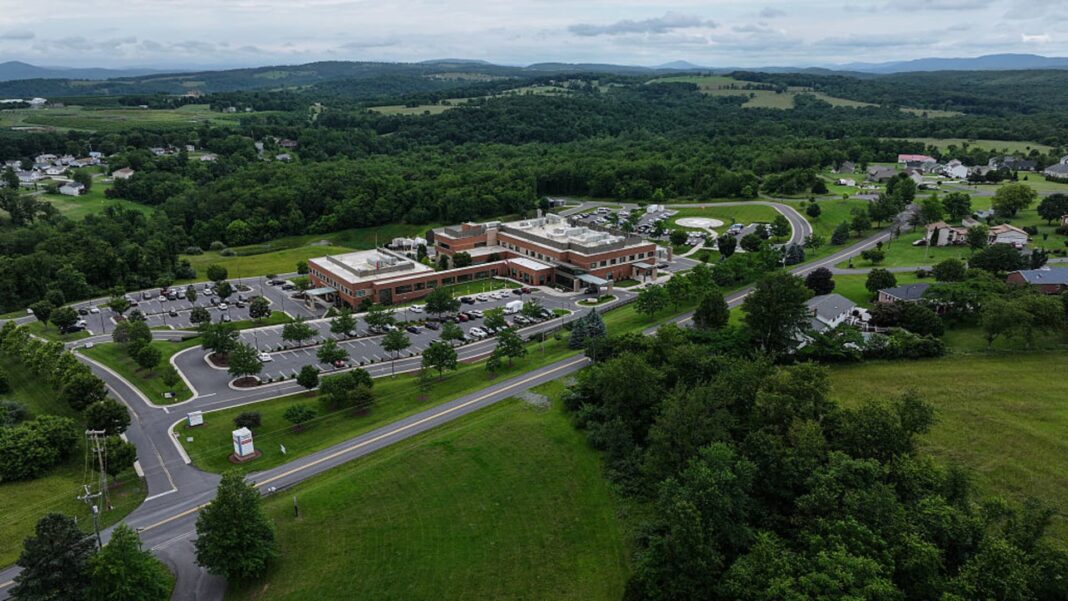An aerial view of Valley Health Hampshire Memorial Hospital on June 17, 2025 in Romney, W.V.
Ricky Carioti | The Washington Post | Getty Images
President Donald Trump’s “big beautiful bill” would make sweeping changes to U.S. health care, leaving millions of vulnerable Americans without health insurance and threatening the hospitals and centers that provide care to them.
The Senate on Tuesday voted 51-50 to pass the spending measure after a marathon overnight voting session on amendments. But the bill will face another major test in the House, where Republicans have a razor-thin majority and some members have already raised objections to the legislation.
Recent changes to the bill would cut roughly $1.1 trillion in health-care spending over the next decade, according to new estimates from the nonpartisan Congressional Budget Office.
More than $1 trillion of those cuts would come from Medicaid, a joint federal and state health insurance program for disabled and low-income Americans, according to the CBO. The funding cuts go beyond insurance coverage: The loss of that funding could gut many rural hospitals that disproportionately rely on federal spending.
The CBO estimates that the current version of the bill would result in 11.8 million people losing health insurance by 2034, with the majority of those people losing Medicaid coverage.
But the implications could be even bigger. Trump’s bill combined with separate policy changes could result in an estimated 17 million people losing health insurance, said Robin Rudowitz, director of the program on Medicaid and the uninsured at health policy research organization KFF.
She said those other changes include new regulations that would dramatically limit access to Affordable Care Act Marketplace coverage and expiring enhanced ACA tax credits.
“If all of this comes to pass, it would represent the biggest roll back of health insurance coverage ever due to federal policy changes,” Cynthia Cox, KFF’s director of the program on the ACA, said in an analysis published Tuesday.
Approximately 72 million Americans are currently enrolled in Medicaid, about one-fifth of the total U.S. population, according to government data. Medicaid is the primary payer for the majority of nursing home residents, and pays for around 40% of all births.
The Trump administration and its allies insist the cuts in the bill aim to eliminate waste, fraud and abuse. Democrats have said they break the president’s repeated promises not to touch the Medicaid program. Medicaid has been one of the most divisive issues throughout negotiations in both chambers, and some House Republicans have expressed reservations about how deep the cuts are.
“I get that they want to cut fraud, but taking a swipe across the top is not going to solve the issue,” said Jennifer Mensik Kennedy, president of the American Nurses Association.
She said the cuts could shutter hospitals and health centers in rural areas and lead to job losses for health-care staff such as nurses.
Millions of Americans will lose coverage
The cuts in the bill come from several different provisions, but the lion’s share of Medicaid savings will come from two changes.
One would establish a new, strict national work requirement for certain Medicaid beneficiaries ages 19 to 64. It would require childless adults without disabilities and parents of children older than 14 to work, volunteer or attend school for at least 80 hours a month to keep their insurance coverage, unless they qualify for an exception.
Current law prohibits basing Medicaid eligibility on work requirements or work reporting rules, according to KFF.
The new work requirement in the bill won’t kick in until 2026. It is projected to save about $325 billion over a decade, the CBO said.
An analysis published June 23 by the UC Berkeley Labor Center said that the work requirement would cause the most people to lose insurance and “poses an especially draconian barrier to older adults.” The center said there is a steady drop-off in employment after age 50 due to factors “outside [people’s] control,” including deteriorating health, age discrimination and increasing responsibility to provide care for aging family members.
“These same factors make older adults particularly vulnerable to coverage loss under Medicaid work requirements,” the analysis said.
People living in rural communities, such as seasonal farmers, may also struggle to find employment for parts of the year, Mensik Kennedy said.
AARP, an advocacy group focusing on issues affecting those 50 and older in the U.S., sent a letter over the weekend to Senate Majority Leader John Thune, R-S.D., and Senate Minority Leader Chuck Schumer, D-N.Y., opposing another provision that would disqualify people who fail to meet Medicaid work requirements from receiving premium tax credits to purchase coverage through the ACA Marketplaces.
“This creates a steep coverage cliff for those in their 50s and early 60s — particularly for those nearing retirement or working part-time — who may be left with no affordable coverage option at all,” the group said.
Hospitals, health centers, patients in rural areas at risk
A surgeon walks past in the surgical unit at Valley Health Hampshire Memorial Hospital on June 17, 2025 in Romney, W.V.
Ricky Carioti | The Washington Post | Getty Images
Another driving source of Medicaid savings will come from a provision that will cap and gradually reduce the tax that states can impose on hospitals, health plans and other medical providers. Those provider taxes are designed to help fund state Medicaid programs, with the federal government matching a portion of the state’s spending.
Some members of the Trump administration and conservative lawmakers argue that it is a loophole for states to receive disproportionately more federal funds than they contribute.
The bill’s restrictions on provider taxes and another strategy called state-directed payments would cut spending by a combined $375 billion, according to the CBO report.
But some GOP senators and experts raised concerns that capping provider taxes would threaten a critical funding stream for rural hospitals, which could force them and other health centers to close. Mensik Kennedy said health-care providers in rural areas, particularly critical access hospitals, rely more on Medicaid funding to support them compared with those in urban areas.
“You’re going to see closures of rural hospitals that are the backbone of their community and were already struggling financially. You’re going to see half a million job losses,” Mensik Kennedy said.
She said pregnant women in rural areas could be forced to drive 30, 40 or more miles to deliver a baby, while emergency medical services could have to drive an hour to reach a patient having a heart attack.
Patients in rural communities already have higher rates of chronic illnesses and mortality because they have limited access to care, according to the Centers for Disease Control and Prevention.
Senate Republicans have added a $25 billion fund to the bill to help rural hospitals stay open in the face of Medicaid cuts.
But Mensik Kennedy said that fund is “putting a bucket of water on the house fire,” adding that it is not enough to offset the cuts from the cap on provider taxes and other provisions.
Cuts in overall Medicaid funding for rural hospitals would exceed 20% in more than half of states, according to a report from the National Rural Health Association.
A win for pharma
Senate Republicans handed a win to drugmakers after they added back a provision into the bill that would exempt more medicines from the Inflation Reduction Act’s Medicare drug price negotiations.
Under the bill, medicines used to treat multiple rare diseases will be exempt from those price talks between Medicare and manufacturers. The Senate initially left out that provision, called the ORPHAN Cures Act, in its first draft of the bill last month.
The pharmaceutical industry argues that excluding those drugs from the negotiations will encourage more investments in treatments for rare conditions. Currently, only drugs that treat a single rare disease or condition can be exempted from price talks.
“The ORPHAN Cures Act will enable more options for Americans living with rare disease,” the trade group Biotechnology Innovation Organization wrote Wednesday in a post on X. The group also said only 5% of rare diseases have an approved treatment, while the economic toll of rare conditions in the U.S. surpassed $997 billion in 2019.
But on Tuesday, drug pricing group Patients For Affordable Drugs Now called on the House to remove the ORPHAN Cures Act from the bill and allow Medicare drug price negotiations to deliver more savings to patients.
The decision to include it in the legislation “moves us in the wrong direction, undermining hard-fought progress to lower drug prices,” Merith Basey, executive director of the group, said in a statement.
“Pharma lobbyists will stop at nothing to maintain industry profits, and when a majority of the Senate caves to their interests, it’s a reminder to Americans why they’re paying the highest drug prices in the world. Simply put: it’s because Congress allows it,” Basey said.
She called it a “completely unnecessary $5 billion giveaway” to the pharmaceutical industry, referring to CBO estimates for how much the ORPHAN Cures Act would cost taxpayers over the next decade.



